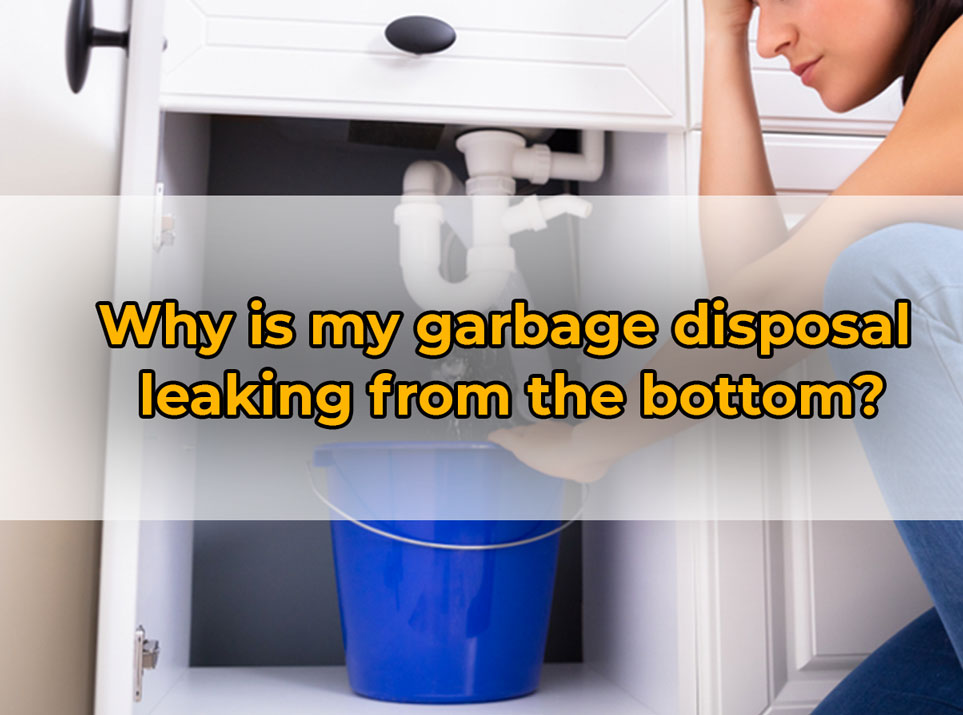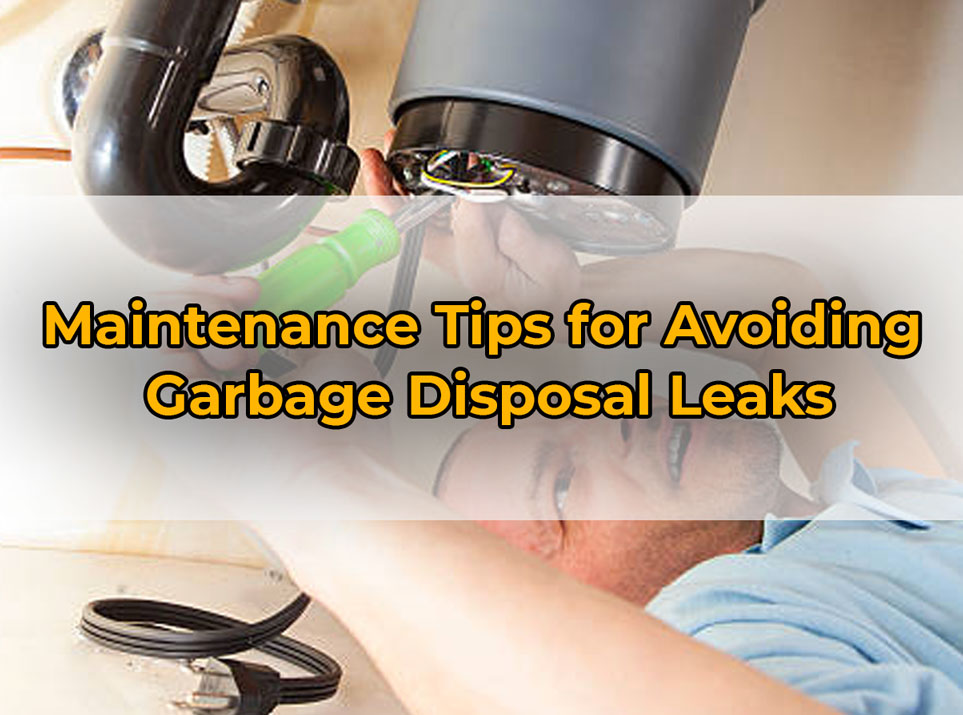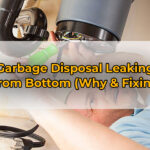Trying to solve garbage disposal leaking from bottom? Garbage disposals are convenient appliances that help us get rid of kitchen waste. However, when they start leaking from the bottom, it can be a major headache.
The first thing you should do is turn off the power to the garbage disposal and unplug it from the outlet. This will prevent any electrical shock or damage to your appliance.
One common cause of a leaky garbage disposal is a worn-out seal. Over time, the rubber seal that separates the sink flange and the garbage disposal unit can wear out, causing water to leak out from under the unit.
Another reason could be a crack in the body of your disposal itself. Old age or physical damage can cause these cracks which means there’s no other way but for you to replace it.
Here is more detailed explanation on why and how to fix garbage disposal leaking from bottom!
Why is my garbage disposal leaking from the bottom?

Garbage disposals are a common household appliance that can experience problems with leakage. If your garbage disposal is leaking from the bottom, there are a variety of reasons why this may be happening. To troubleshoot the issue, follow these steps:
1. Old age or wear and tear
Garbage disposals age over time due to regular use. This wear and tear can cause leaks from various parts, such as the bottom. There may be signs of corrosion or cracks, or blades may be worn down.
If there is a leak from the bottom, check all connections between the disposal and drain pipe. Check the reset button too. If everything looks okay but the bottom is still leaking, it might be time to replace the whole unit.
Improper installation or loose connections can also cause leakage. Fixing these kinds of issues early is important, before more damage happens.
2. Loose or broken connections
Loose or broken connections from regular usage or incorrect installation can lead to water leakage in garbage disposals. This needs to be fixed quickly, to prevent damage and contamination.
- The discharge tube connections may be loose, causing water to leak from the bottom.
- Leakage can also occur when there’s a broken seal between the sink flange and disposal assembly.
- Old rubber gaskets and worn-out mounting screws can cause water to leak out.
Ignoring these problems could lead to greater damage. Thus, it’s essential to check your garbage disposal frequently and fix any issues. If you don’t know how to do this, get help from an expert.
Improper DIY installations by untrained homeowners can also be a cause of loose or broken connections. Therefore, it’s best to hire a licensed pro for such tasks, rather than doing them yourself.
Your garbage disposal might be saying ‘Leakage? No, I’m just excited to have you feed me all those delicious leftovers!’
3. Cracks or damage to the unit
It seems as though your garbage disposal is feeling left out and is attempting to escape through the bottom due to damaged or cracked parts. Here are some things that may have caused the cracks or the damage:
- Broken impeller blades, you can see the sign like Garbage Disposal Humming but Not Working.
- Worn out bearings in motor shafts
- Faulty flywheel seals
- Damaged motor housing
- Loose mounting bolts and screws
But, if these fixes don’t stop the leaks, it’s probably because of something else. In such a case, it’s best to call an expert.
Don’t forget, small cracks can turn into bigger ones and cost you more if not taken care of straight away.
A study by the Environmental Protection Agency (EPA) discovered that in 2018, Americans generated 292 million tons of solid waste and composted 68 million tons of materials.
4. Rust or corrosion
Leakage in garbage disposals may be due to chemical degradation or microbial activities that weaken components. Rust and corrosion occur when these factors hinder moving parts.
It’s important to note that the rusting and corroding happens gradually. Maintenance is needed, like cleaning with mild agents.
Studies show that acid, salt, or product residue can accelerate corrosion and rust, causing cracks at joints. This leads to unpleasant odors and health hazards.
The EPA states an average American household generates 4 pounds of trash per person, per day. This shows why proper waste management is essential for a healthy environment.
5. Improper installation
The garbage disposal leaking at the bottom could be due to incorrect setup or placement. This can cause severe issues and requires quick attention. Here are four steps to combat improper installation:
- Relocate the Disposal – If not aligned properly with the sink, it may create leakage. Loosen and tighten screws to align correctly.
- Tighten Connections – Check for loose pipes or mounting assembly that can cause leakage and tighten them.
- Check Rubber Gaskets – If the rubber gasket at the top of the mounting assembly or flange gives away, water will seep into lower surroundings. Replace the old one with a new one.
- Replace Worn Parts – If the disposal machine has passed its expiry date, it can break down and cause leakage. Upgrading worn parts regularly will help avoid this.
It’s key to search for signs like corrosion or cracks on the disposal machinery that can worsen ‘Improper installation.’ Don’t overlook these signs for safety.
DIY garbage disposal installation often leads to costly replacements or repairs. Thus, hiring professional help is recommended. Get ready to investigate the problems with your garbage disposal!
Fixing Garbage Disposal Leaking From Bottom

Fixing a Leaking Garbage Disposal: Simple and Quick Solutions
If your garbage disposal is leaking from the bottom, it can cause a lot of problems, including water damage, rust, and unpleasant odors.
Fortunately, fixing a leaking garbage disposal can be a simple and quick process that doesn’t require professional help.
1.Turn off power to the unit
Before you get to work on your garbage disposal unit, you must turn off the electrical supply, check if garbage disposal wont turn off. Here’s how:
- Locate the dedicated circuit breaker in your electrical panel.
- Switch off the circuit breaker.
- Make sure all cords and plugs are disconnected.
Be careful with electricity! Forgetting to switch off can lead to electrocution and injuries. So take caution. Neglecting safety measures can result in life-threatening accidents. Stay aware and stay safe!
To find a leak in your disposal unit is like looking for a needle in a pile of trash – unpleasant but necessary.
2. Locate the source of the leak
Discovering where your waste disposal unit is leaking can save you time and money. Take a peek to see if it’s coming from the sink flange, dishwasher hoses, or the disposal itself. Here’s a guide for locating the source:
- Clear water from the sink.
- Unplug dishwasher hoses and other connections.
- Look below the sink for water leakage and its source.
Check if there are any damp patches that might show an issue inside your appliance or nearby. Swiftly detecting the leak stops damage and stops throwing away materials.
Knowing how to detect a leaking garbage disposal can help you avoid costly repairs and accidents. Don’t let a repair go overlooked – patch it up right away. When it comes to disposals, some slack connections just need a little tightening to be fixed.
3. Tighten loose connections or replace broken parts
To fix a defective garbage disposal, it’s essential to check and fix any loose attachments or replace any worn-out parts. Poor connections can stop the disposal’s functioning, and broken pieces can cause leaks or even bigger damages. Thus, follow these steps:
- Turn off the power supply for safety.
- Locate the source of the problem and detach any broken components by unscrewing them with an adjustable wrench.
- Tighten or replace the damaged attachments with the same method – but don’t apply too much pressure.
- Put back all the pieces and test the disposal to make sure it works properly.
Be aware that using a regular screwdriver instead of an adjustable wrench can harm important components due to excessive force. Therefore, take care when handling it.
Preventing issues is better than waiting for them to become serious, which can lead to expensive repairs or putting yourself in danger. It’s key to understand that taking good care of your equipment pays off in the long run.
Sealing up cracks may not solve life’s issues, but it’s a start!
4. Apply plumbers putty or sealant to cracks or damaged areas
If your garbage disposal is leaking, you must fix the cracks or damaged areas before attempting any repairs. A great approach is to use sealant or putty on the affected areas. Here’s a 6-step guide to applying it:
- Turn off the power.
- Empty the disposal and clean the area around the damage.
- Follow manufacturer instructions for preparing the putty/sealant.
- Apply a generous amount to the crack/affected area.
- Allow enough time for drying according to manufacturer instructions.
- Reconnect the power and check if it works.
It’s important to pick a suitable sealant/putty for your garbage disposal. Look in the user manual for recommendations, talk to a pro plumber, or search online for compatible parts with sealers.
Pro Tip: After it’s dried, clean up any extra putty/caulk to ensure proper performance. Say goodbye to your old disposal, it’s been grinding for too long – time for a new pal!
5. Replace the unit if irreparable or too old
If your garbage disposal is irreparable or outdated, replace it! Here are 4 steps to do so:
- Disconnect the power supply by unplugging the unit or turning off the circuit breaker.
- Remove any attachments connected to the unit: plumbing or electrical connections.
- Remove the old unit and get the area ready for a new one.
- Install the new garbage disposal and make sure all attachments are connected properly.
When buying a new disposal unit, pick one that fits your sink’s plumbing and has enough horsepower for your household’s needs. Furthermore, newer models have better tech than old units, like improved efficiency & noise reduction.
Consumer Reports recommends InSinkErator and Waste King for their durability & performance. Don’t ignore your garbage disposal – it’s like ignoring a crying baby – it’ll create a mess eventually! Check also: Frigidaire Dishwasher Not Starting.
Maintenance Tips for Avoiding Garbage Disposal Leaks

Preventing leaks from your garbage disposal system is essential to keep your kitchen clean and hygienic. Here are some tips to help you avoid having a leaky garbage disposal system.
Did you know that a garbage disposal system was invented in 1927 by John W. Hammes in Racine, Wisconsin? Grinding food waste with cold water may be chilly, but it’s the hottest tip for keeping your garbage disposal in top shape.
1. Use cold water when grinding food waste
Cold water is essential for a working garbage disposal. Follow these steps to avoid costly repairs and keep the kitchen fresh:
- Turn on the cold water before putting food waste in. This helps solidify oils and fats which avoids clogs.
- Put only small pieces of food at a time.
- Run cold water for 30 seconds after turning off the disposal, to flush out any remaining debris.
- Hot or warm liquids and hot water must be avoided during the grinding process.
Also, fibrous, starchy or hard materials should never be flushed down the disposal. This can cause clogs and damage.
Professionals recommend getting your garbage disposal checked yearly, to prevent dangerous leakages. 75% of all emergency plumbing calls are due to lack of maintenance by homeowners. So, it’s important to pay attention to appliances like garbage disposals.
Remember, your disposal isn’t a miracle worker. Don’t try to grind a whole Thanksgiving feast in one go!
2. Don’t overload the unit with too much waste at once
Don’t overload your garbage disposal! It can cause problems like leaks and other malfunctions. Here’s what you can do:
- Put in small amounts at a time.
- Don’t dump it all at once.
- Cut large pieces into small ones.
- Don’t stuff food down the drain.
- Run cold water for 15 seconds after use.
Leakages and damage mean extra repair costs. Plus, less waste in the garbabe disposal means less waste in landfills – helping the planet! So, be a hero and help your garbage disposal unit by not overloading it!
3. Avoid grinding hard or tough items
It’s important to take precautions when grinding food waste. Keep your hands away from the unit when it’s running and don’t use harsh chemicals that could corrode it.
Avoid grinding hard or tough items like bones, shells, coffee grounds, fruit pits, and citrus peels. Fibrous foods like corn husks, celery stalks, and onion skins can also damage the motor. Grind small amounts of soft food waste at a time and rinse it before and after.
Don’t throw in plastic wrappers, rubber bands, or bottle tops either – these items can cause problems with how your unit works. To keep it running smoothly, run cold water before use and use ice cubes to sharpen the blades. Sticking to these healthy habits will save you money in the long run by preventing leaks.
4. Clean the unit regularly with vinegar and baking soda
Clean your garbage disposal unit to avoid leaks and keep it running smoothly. Use vinegar and baking soda for a natural and effective clean. Here’s a 6-step guide:
- Turn off power supply
- Pour half a cup of baking soda into the unit
- Pour one cup of white vinegar on top
- Cover the drain and let the mixture sit 10-15 minutes
- Uncover and run hot water down it for a minute
- Switch on power supply when done.
Remember to use only cold water when pouring vinegar. Don’t add ice, as it could jam up your unit. Only do this for mild clogs.
Regular cleaning is important to avoid costly repairs or replacements. Plumbers have found that most garbage disposal leaks are due to lack of maintenance. Skip the therapist; maintain your garbage disposal instead!
5. Get regular professional maintenance checks on your unit.
Regularly get a pro to check your garbage disposal system. An experienced tech can spot issues early and carry out repairs. This boosts the unit’s life.
Specialists inspect the blades, motor, pipes and joints. They also clean the inside of the unit and give advice to improve performance. Maintenance helps keep the area hygienic and clean.
Servicing your garbage disposal often can save money in the long run. Unmaintained disposals usually break down, needing expensive fixes or replacing.
Don’t forget regular check-ups by a qualified person are necessary to prevent garbage disposal leaks. Schedule your next maintenance check now!
Should I unplug a leaking garbage disposal?
Yes, While it may seem like the best course of action is to unplug the unit, this may not necessarily be the best solution. The decision on whether or not to unplug your leaking garbage disposal depends on several factors.
Firstly, you need to assess the extent of the leak and the cause. If it’s a minor leak caused by a loose connection or worn out gasket, you can safely continue using your garbage disposal after fixing it. However, if there’s significant damage to the unit or if sewer gases are escaping from it, then unplugging is necessary for safety reasons.
Secondly, consider whether unplugging will solve the issue completely. If your sink drain is clogged or damaged pipes are causing backups in your system, unplugging will only provide temporary relief.
How long should a garbage disposal last?
Typically, most garbage disposals can last for about 8-15 years if used and maintained properly. This means that you need to make sure that you use it correctly and avoid putting things like fibrous vegetables, bones or non-biodegradable items down the drain.
These materials can damage your disposal’s motor or blades and ultimately shorten its lifespan. Additionally, it is important to keep your disposal clean by running cold water after each use and grinding citrus peels or ice cubes occasionally to help freshen up the unit.
What happens if you run your garbage disposal too long?
Firstly, overuse can cause the motor to overheat. This can lead to a burnt-out motor and an expensive repair bill. Additionally, if the blades are spinning too fast for too long, they can become dull or even break off entirely. When this happens, your garbage disposal will no longer be effective at grinding up food waste and will need to be replaced.
Another potential issue is clogging. Running your garbage disposal for too long can cause debris to build up in your pipes and create a blockage.
“There is no real ending. It’s just the place where you stop the story.”






